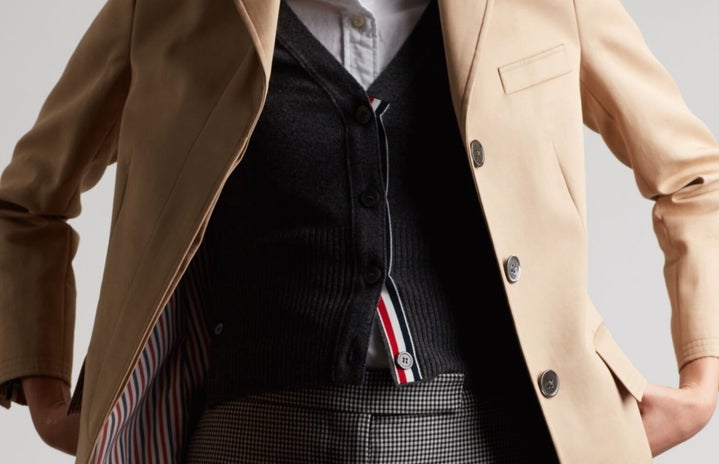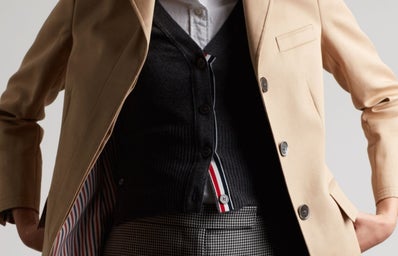All eyes are on the duo embracing in front of a white backdrop. The photographer shuffles around in an attempt to get the perfect angle. Cameras flash. *click*. *snap*. Agreeing on a position, the pair transition into another pose. The room radiates with artistic ambiance.
Wait a minute. Is that Timothée Chalamet and Saoirse Ronan? “Wow, what a surprise! But why are they wearing each other’s clothes?” is what an admirer might say.
An Entertainment Weekly (EW) cover shoot shows us the series of striking portraits of the rising stars, who gave a refreshing performance as Josephine (Jo) March and Theodore (Laurie) Laurence in Greta Gerwig’s Little Women (2019), based on Louisa May Alcott’s classic novel.
In the first photo, Ronan wears a plain, collared shirt, and Chalamet is in a white silk blouse. In further slides, the two don more unusual outfits and displays. Although it is easy to overlook these details, they offer important insights into our social construction of masculinity and femininity. Prevalent gender codes cause us to view men as active and women as passive. It is only when these roles are reversed in the media that we become aware of this discrepancy and view it as peculiar.
Despite the explicit statement by EW that this photoshoot was “gender-bended”, over half of the comments described their clothing and demeanor rather than the actual interview. Analyzing the comments section sheds light on society’s current expectations of gender roles. Users quipped: “I [t]hought Timothée was a [h]ot super model, had to look twice to realize it was him and not a woman” and “Two nice looking ladies.”
Some question the two friends’ sexuality with comments like “What a handsome lesbian couple” and “Timothée does not walk the straight and narrow path.” Does wearing atypical clothes in a single photoshoot automatically dictate an individual’s sexual and gender identity?
Another user stresses the departure from normative gender roles: “It’s impossible to tell which one is male and female. I remember a time when men looked masculine, and women feminine. Men did not wear their sister’s/girlfriend’s/mother’s clothing”. In his eyes, Chalamet and Ronan have failed to measure up to his standards. But who are we to define what masculinity and femininity entail?
A viewer responds to him: “What about the time before that, when men in royalty wore flowing and feminine clothing?” She reminds us that, historically, people did not participate in the gender markers familiar to us today. By acknowledging that gender markers are learned rather than inherent, it is apparent that our depictions of femininity and masculinity depend on our ever-changing values.
What is more interesting is that this is a cover shoot promoting the film Little Women, where iconic feminist character Jo March avoids the life of a ‘normal’ woman, as she prefers to pave her own path as a writer against patriarchal expectations.
Jo, who wishes to have been born a boy, wants to fight in the Civil War. She wears men’s clothing and desires the advantages that being a boy brought during the 19th century. Costumer Jacqueline Durran’s designs for Jo reflected this idea with vests, button-down shirts, blazers, and neck-scarves.
EW details that “their androgynous fashion performance here reflects their wardrobe shake-ups in Little Women.” As Jo and Laurie’s friendship strengthened, Durran had the two swap outfits during filming to reinforce the “masculine-feminine fluidity” between the characters.
In another interview, Gerwig plainly stated that “Jo is a girl with a boy’s name and Laurie is a boy with a girl’s name. In some ways, they are each other’s androgynous twin”. She continued, “It wouldn’t be wrong to call Saoirse handsome and Timothée beautiful. Both have a slightly androgynous quality that makes them perfect for these characters.”
This actor and actress have been no exception to the recent trend of breaking down walls of traditional gender binary. Chalamet has made quite the name for himself with his bold fashion choices, as he has worn outfits from female clothing lines. Often regarded as a ‘soft boy’, he is redefining traditional masculinity and what it means to be a leading man in pop-culture. Instead of displaying conventional traits of manhood such as power, strength, and heterosexual prowess, soft boys are known to embrace emotional intelligence and the occasional feminine apparel.
By playing critically acclaimed roles in works such as Lady Bird and Beautiful Boy, these two young stars are undeniably on their way to becoming household names. Much like Jo March, who exists outside of gender norms, Ronan and Chalamet are “adamantly being themselves in the public eye, and subverting gender norms.”
So, why is any of this significant? Something particularly interesting is that some commenters were actually comfortable labelling Ronan and Chalamet as a lesbian couple, but unwilling to accept fluidity within evolving gender systems. It seems that though same-sex relationships have gained recognition in our society, which was a rare mindset even a decade ago, this only applies if a couple can stay within firmly ingrained gender norms of masculine versus feminine. Though there is much to be unveiled and learned, the photoshoot itself highlights the progress of what it means to be masculine, feminine or anything in between. The responsibility now lies within us and how we choose to react to unfamiliar forms of expression in the media.


